 Back to selection
Back to selection
Shutter Angles
Conversations with DPs, directors and below-the-line crew by Matt Mulcahey
“Often We are Communicating Without Words”: DP Daniele Massaccesi on The Matrix Resurrections
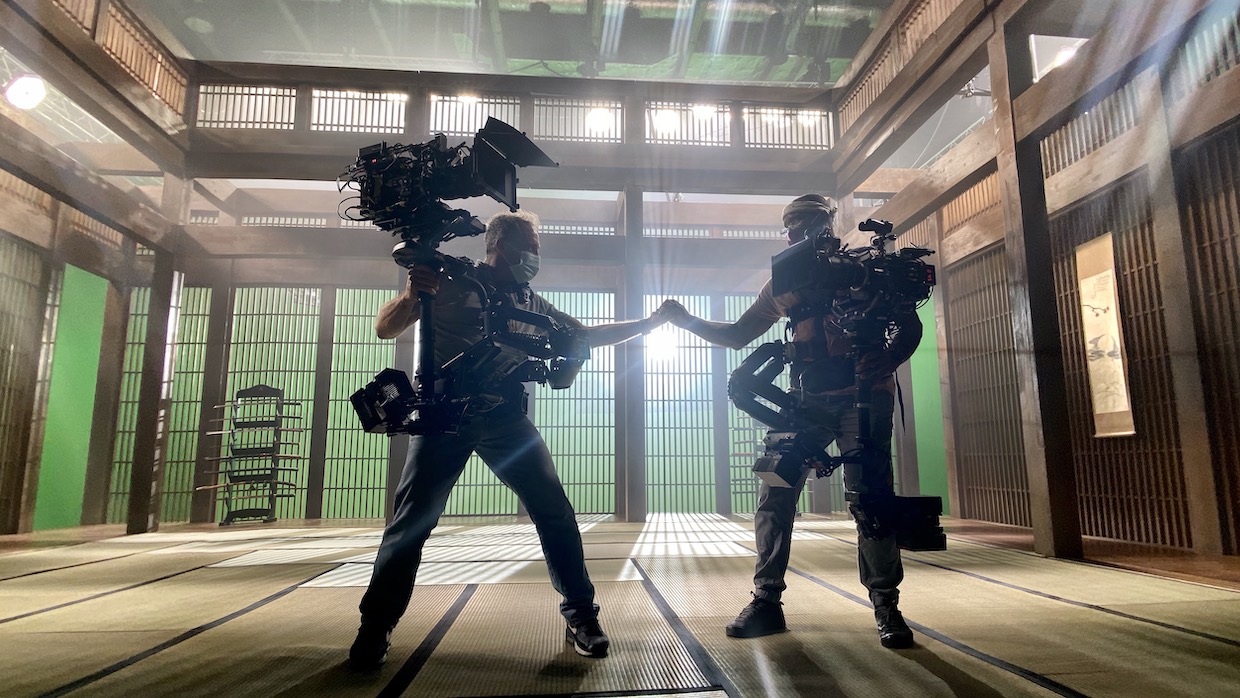 On the set of The Matrix Resurrections
On the set of The Matrix Resurrections After more than 25 years of making movies alongside her sister, Lana Wachowski’s first solo feature revisits the siblings’ most famed creation with a new installment of The Matrix, The Matrix Resurrections.
Daniele Massaccesi knows something about making movies with family. The Matrix Resurrections co-cinematographer grew up on the sets of his father, Aristide Massaccesi, a cult figure in the 1970s and 1980s Italian exploitation era who often worked under the pseudonym Joe D’Amato. Daniele Massaccesi eventually graduated from lugging batteries and lens cases on his dad’s Italian Mad Max and Conan the Barbarian variations to become a sought-after Steadicam operator, working frequently on the films of Ridley Scott and the late Anthony Minghella. He first crossed paths with the Wachowskis on Speed Racer, where he contributed some additional unit work. He’s been a fixture on their crews ever since, operating the camera on Cloud Atlas, Jupiter Ascending and the Netflix series Sense8.
Massaccesi began the Matrix Resurrections shoot in February of 2020 in his normal post as camera operator, working with cinematographer John Toll (Braveheart, The Thin Red Line) on location shooting in San Francisco. Shortly after the crew relocated to Germany in March, COVID shut down production. When filming resumed in August 2020, Toll opted not to return and Massaccesi was elevated to cinematographer for the remainder of the shoot. Massaccesi spoke to Filmmaker about that ascension as well as melting Red cameras, putting the zoom control in the hands of the director and how he shot Resurrections’ stars leaping from a 500-foot building.
Filmmaker: I have a lot of affection for the 1970s/80s era of Italian exploitation films. Tell me about working on some of those movies with your dad.
Massaccesi: During the summer when I was on school break I would always go with my father on set and was around the camera. That was my love from the beginning, probably from when I was 17. My grandfather was in the business as well. He had a camera rental house in Rome. So, since I was a baby I’ve always been around film equipment and people talking about movies.
Filmmaker: And before he was a director, your dad was a cinematographer as well.
Massaccesi: Yeah and I think being a DP was the job he liked the most. He was always talking about lighting and the camera. He decided to move into other (roles in production), but he was always lighting his movies himself.
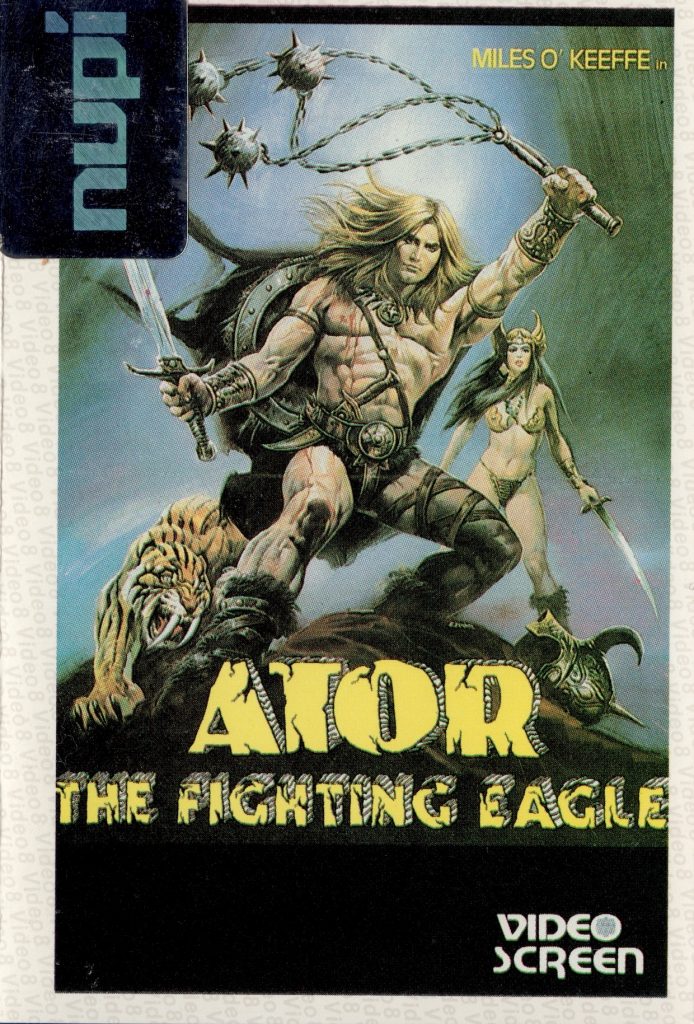
Filmmaker: Did you work on Ator, the Fighting Eagle with your dad?
Massaccesi: I did, yes. (laughs)
Filmmaker: When I was around 6 years old my dad bought our first VCR and the first two movies he rented were Frogs and Ator, the Fighting Eagle. That double feature was one of the seminal moviegoing experiences of my life. We didn’t have cable yet, so before the VCR you were stuck watching whatever happened to be on television. Can you humor me with an Ator story?
Massaccesi: When we were shooting that, it was the soccer World Cup. So, whenever Italy was playing we’d wrap at two in the afternoon and the whole crew would watch the matches. So, very short days. (laughs)
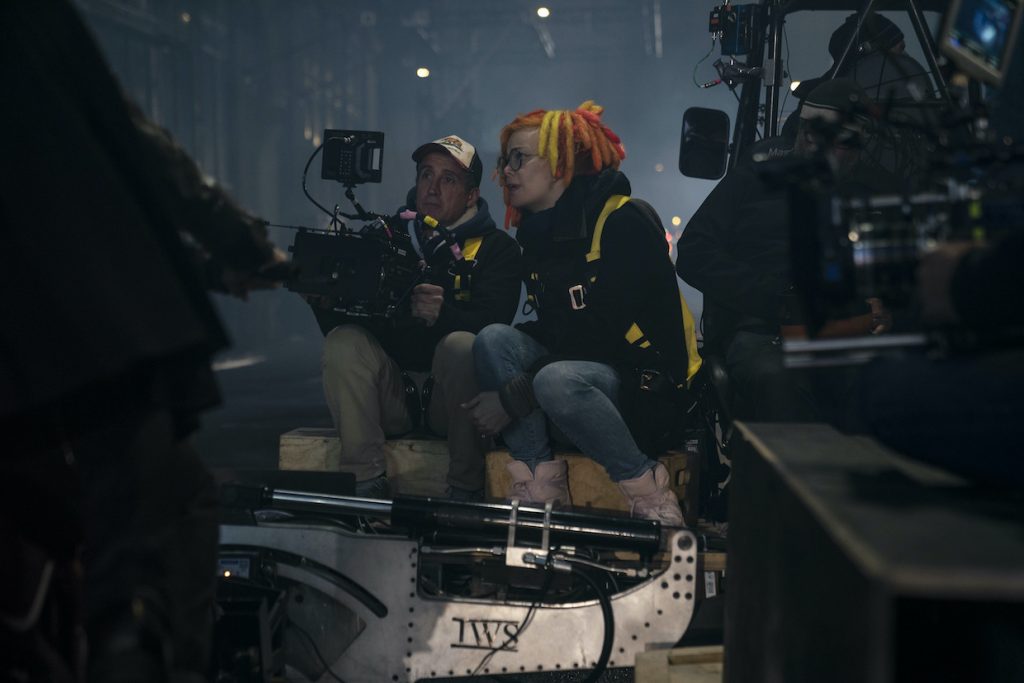
Filmmaker: When John Toll decided not to return for the remainder of the Matrix Resurrections shoot, how much notice did you have before production started up again in Germany?
Massaccesi: Right before we resumed production, he called me saying he wasn’t going to finish the movie. That’s when Lana said, “Well, I think Daniele should finish it.” Since Sense8, she was always next to me with the Steadicam and I was always somewhat involved in the lighting as well, because I would suggest things to her like, “We should not move the camera over there because the lighting in that direction is not going to look great.” So, she decided to give me a chance. It was challenging and a bit stressful in the beginning, but I think it worked out very well.
Filmmaker: Normally on a movie of this scale there’s a very clear roadmap because of all the previs. You’d have storyboards, concept art and maybe even animatics for all the complicated action pieces. But beginning with Sense8, Lana has embraced this new approach that favors improvisation. So when you took over, it’s not like you could just connect the dots and follow the previs plan exactly, because Lana might change the fight choreography or the coverage at any moment.
Massaccesi: Yes, she definitely likes flexibility. She doesn’t want to be locked down to a plan. I would try to consider what possible angles she might want to look from and have lights ready to go, so that I could adjust for whatever she wanted to do with a shot. She was always very collaborative. If I had a problem, I would tell her and she would adjust.
Filmmaker: In the press notes, Jessica Henwick, who plays Bugs, said that she always had to be ready because she never knew when the camera might end up on her. The coverage might start on another actor, with Henwick off-camera just to feed lines, but at any moment Lana might whip the camera around to her and all of a sudden now she’s the focus of the shot. That’s a challenge for you, because you have to light those spots in case Lana decides to unexpectedly pivot in that direction.
Massaccesi: My gaffer was always at my side so whenever Lana would decide to swing the camera around he would very quickly adjust the lighting—maybe dim one light down or bring another one up. We were using all LEDs, so he could make those adjustments in seconds on the iPad. We would already have a plan where we would say, “Okay, for the master this will be the lighting, then we’ll go to this look for this actor’s close-up, then do this when we are on the reverse close-up.” So, we could make quick adjustments during the shot, because we were organized and ready.
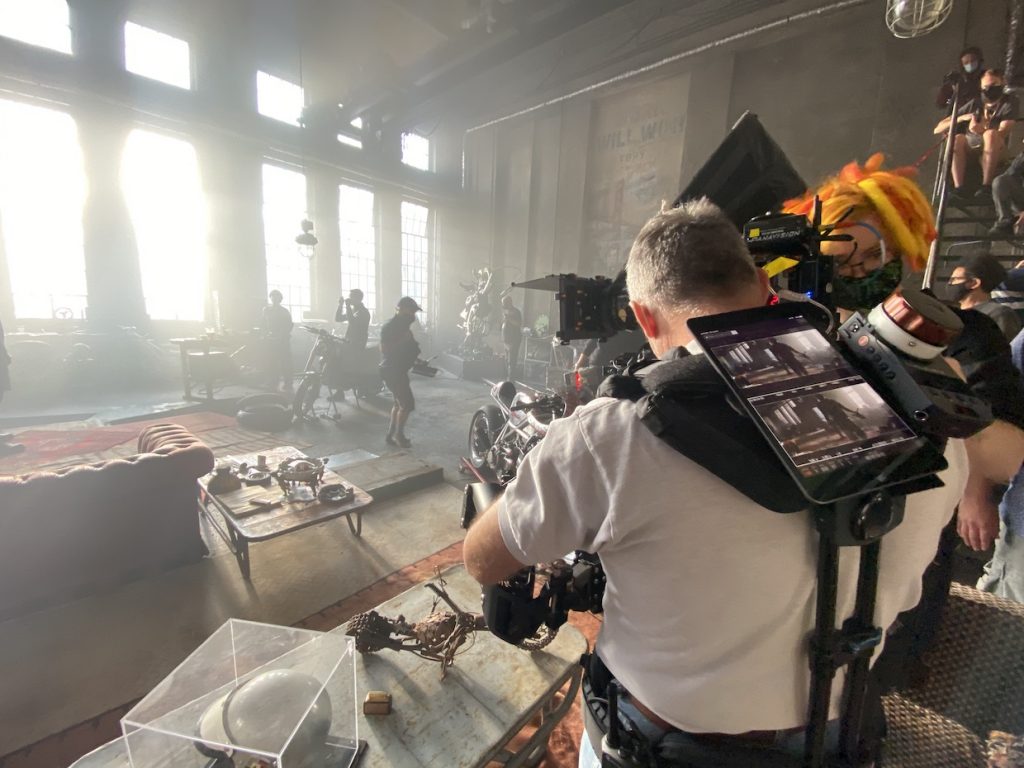
Filmmaker: Tell me about this unique method you have of operating the Steadicam when you work with Lana. She’s right next to you with a hand on your shoulder, you move in tandem and she’s giving you notes and adjustments on the fly as you’re rolling.
Massaccesi: All she has to do is whisper in my ear if she changes her mind or even put a bit more pressure on one side so I know to go in that direction. Often we are communicating without words and it makes things very efficient.
Filmmaker: In the picture above, are the iPads on the back of your Steadicam vest Lana’s monitor for your shot?
Massaccesi: No, that shows her the B Camera shot. She sees what I’m shooting on [the monitor attached to my Steadicam]. And that little [wheel] on my right shoulder is the zoom control so she can zoom in the middle of a take.
Filmmaker: Does that change the balance of the Steadicam?
Massaccesi: There is a little bit of shifting weight, but I can handle it. The process of putting the camera down and changing the lens just kills the whole momentum of the scene. Even sometimes just grabbing the lens [to zoom manually] will lose the energy. Having that zoom control, Lana can just quickly zoom in and it’s very quiet with no messing around.
Filmmaker: If you’re always moving with the Steadicam and the path of that movement isn’t set in stone, how do you figure out the best place for your second camera?
Massaccesi: When we had two cameras, the other one might be handheld or sometimes we did two Steadicams at once. [Our camera operator] Kirk Gardner was very good. If he was on the edge of my shot, I would give him a look and we could quietly communicate that way. Sometimes we would end up in each other’s shots, but if that happened we would adjust. Sometimes we’d get an entire scene without cutting the camera, just one long take.
Filmmaker: Physically, it has to be hard to fly the Steadicam for that long.
Massaccesi: It is, but whenever I’m concentrating on the shot, to be honest, I don’t feel anything else. I don’t feel cold. I don’t feel hot. I don’t feel the weight. I’m concentrating on what I’m doing and everything else is not important. But when they need to reload, I am thankful to get to put it down. (laughs)
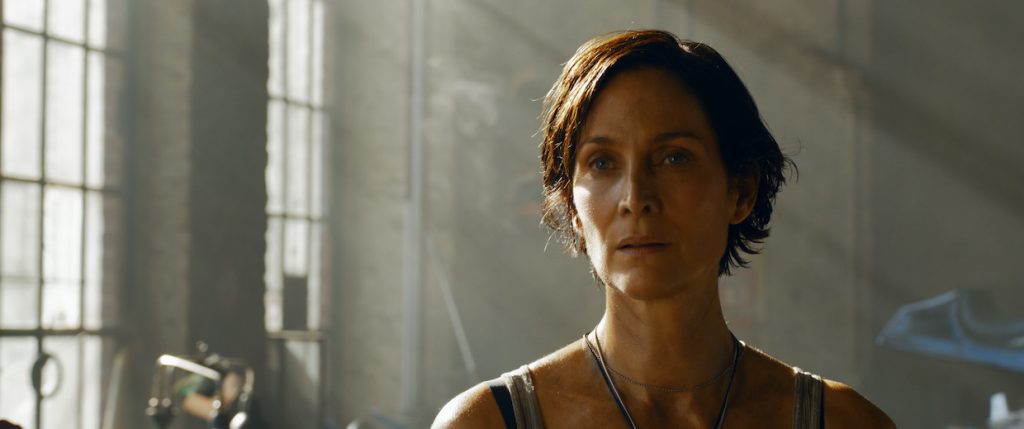
Filmmaker: Is the Trinity motorcycle shop location a practical space or a backlot set at Studio Babelsberg in Germany?
Massaccesi: That was a real location—I think it was an abandoned factory, and it had this big open space with big windows. The lighting was mostly done by the sunlight, so we were only able to shoot there from 8am to 11am, when the sun just cracked the horizon. Sometimes we would use artificial light to do some inserts and close-ups, but mostly it was all done with sunlight. We liked the contrast in that scene, so the opposite side of the room from the windows was pretty dark. When we were doing close-ups, I did use a bounce to wrap the light a bit more around their faces for more fill so it wasn’t too much contrast, but that was all done by hand with a grip holding the bounce. So, it was very quick.
Filmmaker: You shot most of the movie on Red Ranger Monstro cameras, but you were able to get your hands on a very early version of the Red Komodo. What did you use those for?
Massaccesi: We got the first one when we were still shooting in San Francisco. It was so small that it was like, “Wow, we can put this anywhere.” We used it mostly as a crash camera and actually we melted one. (laughs) At the end of the motorcycle chase scene there’s a big explosion after a car flips and we had one of those cameras a bit too close and it melted. We were able to save the footage, though.
Filmmaker: Were you using one of your Panaspeeds on that shot and did that get melted too?
Massaccesi: No, we put a little crash camera lens on that because we knew that camera might get into trouble. We just used some cheaper stills lenses and created a PL mount for them.
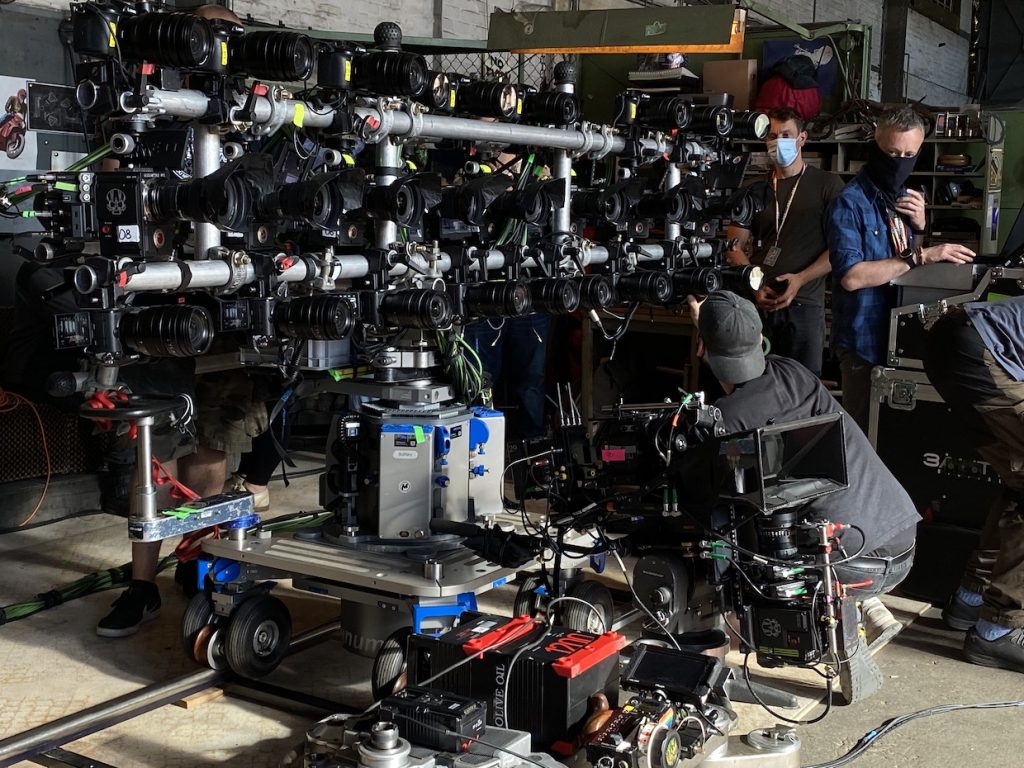
Filmmaker: Explain to me this crazy rig (pictured above). What am I looking at here?
Massaccesi: Originally, we were going to try to have 100 Red Helium cameras to recreate the famous bullet time shots [from the original Matrix trilogy]. [SPOILERS FOLLOW] We were going to use it for a scene where The Analyst [played by Neil Patrick Harris] fires a gun at Trinity [Carrie-Anne Moss. The Analyst would move at normal speed and everything else would move at slow speed. But when we were discussing it, the visual effects team said, “It’s going to take a whole day to set up this one shot.” The scene involved so much dialogue and so much emotion that Lana didn’t want to spend one day just to get that one shot. So we said, “Well, how can we do it differently?” I said, “Well, if one actor is moving at slow speed and another actor is moving at fast speed, why don’t we get a stereo rig [similar to what would be used to shoot 3D]?” When you shoot 3D, the cameras are slightly off, but we aligned them so that we had two cameras that could get the same shot. One camera shot eight frames a second and the other camera shot 120 frames per second.
Filmmaker: How did you handle lighting for a scene with two cameras shooting at such different frame rates? You want to use the same aperture, because you’re going to combine the shots and you want the depth of field to be similar. But the high frame rate camera is going to need a lot more light than the undercranked one.
Massaccesi: We did try to do as much as we could at the same stop so we’d have the same depth of field. We put ND on the eight frames per second camera so the cameras could shoot [at the same stop]. We didn’t actually end up using the rest of that rig in that photo—the part with all the Helium cameras”for that scene. We used that later for the scene at [the coffee shop] Simulate where Trinity wakes up and screams [and you see all these different versions of her branch off around her].
Filmmaker: Let’s finish with the incredible stunt of Trinity and Neo (Keanu Reeves) leaping off a San Francisco high rise. I am terrified of heights. If I even watch a scene in a movie where the characters are high up, my hands start sweating. And here you’ve got your two stars jumping off a building 500 feet in the air.
Massaccesi: All of the shots in that scene are practical. We shot that over multiple days. We were shooting nights doing the chase scene and around midnight we would look at the forecast to see what the weather was going to be in the morning. If it was going to be cloudy, we’d just go home and go to sleep. If it was going to be sunny, we’d go up on the roof and try to get those shots.
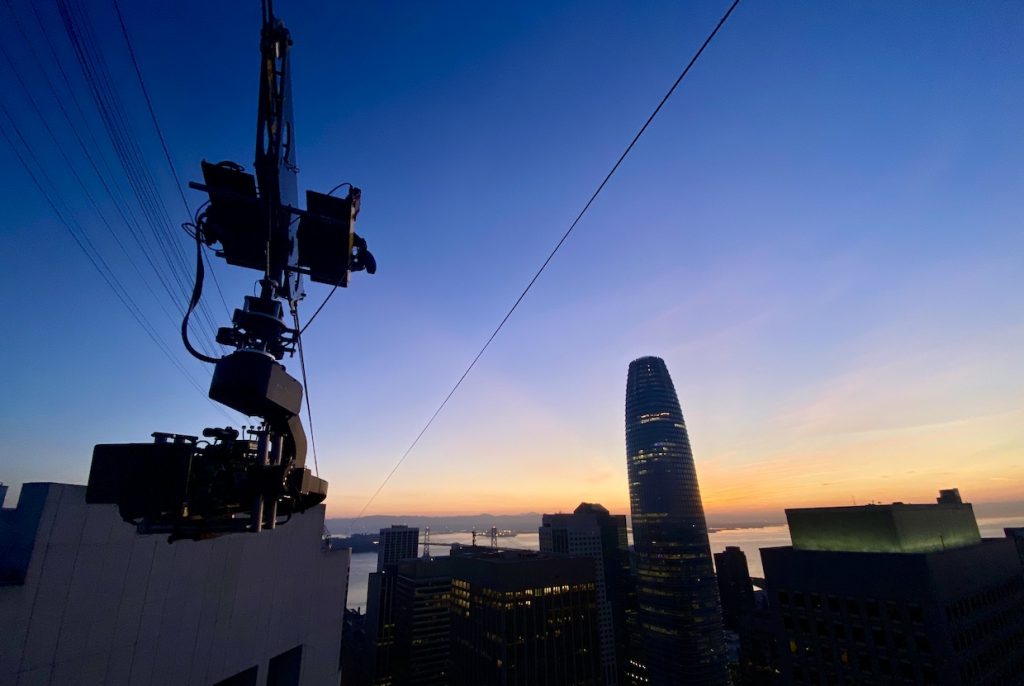
Filmmaker: You’ve worked with Ridley Scott quite a few times and he would probably cover that stunt with 47 cameras. How many did you use?
Massaccesi: For that shot we had four cameras. We had the wire cam [pictured above]. We had a helicopter camera getting a wide shot with the [San Francisco] bay in the background and the sun reflecting on the water. Then we had two other cameras on nearby buildings on long lenses. The key was to get the proper sunlight. We only had a 30 minute window each morning where the light was right.
